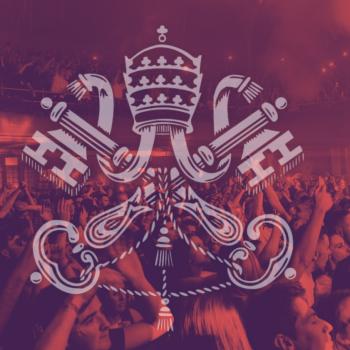By Christine Valters Paintner - May 18, 2009
- Letter of Pope John Paul II to Artists
.png) Art is an ancient and universal language used to confront life's difficulties and find ways of healing. The power of dance, music, ritual, and poetry have long been used to reveal and teach. Catholicism, as a two thousand year-old faith tradition, is thoroughly rooted in the power of the imagination. Myth, symbol, image, and metaphor are at the heart of the ways in which we try to understand reality and God - from psalms to icons, cathedrals to parables. The theologian and artist Jeremy Begbie writes that "The urge to make and enjoy art seems to be universal: the impulse to scratch out images on stone walls, revel in the delight of notes strung together, shape and re-shape words into patterns, and so on." He goes on to say that these activities go beyond entertainment and self-expression, that "they can also reveal, disclose, open up the world we live in, and in unique ways. In other words, they can be vehicles of discovery." The creation of art offers a vehicle of discovery - a discovery of insights into who we are, who God is, and who God calls each one of us to be - which is at the heart of using art as a form of prayer. All of the arts are rooted in a physical process, providing us with an increased awareness of our senses. This helps us to bypass critical thinking and to respond from our bodies and sensual awareness. It also gives God other ways to speak to us while providing us with other ways to respond.
Art is an ancient and universal language used to confront life's difficulties and find ways of healing. The power of dance, music, ritual, and poetry have long been used to reveal and teach. Catholicism, as a two thousand year-old faith tradition, is thoroughly rooted in the power of the imagination. Myth, symbol, image, and metaphor are at the heart of the ways in which we try to understand reality and God - from psalms to icons, cathedrals to parables. The theologian and artist Jeremy Begbie writes that "The urge to make and enjoy art seems to be universal: the impulse to scratch out images on stone walls, revel in the delight of notes strung together, shape and re-shape words into patterns, and so on." He goes on to say that these activities go beyond entertainment and self-expression, that "they can also reveal, disclose, open up the world we live in, and in unique ways. In other words, they can be vehicles of discovery." The creation of art offers a vehicle of discovery - a discovery of insights into who we are, who God is, and who God calls each one of us to be - which is at the heart of using art as a form of prayer. All of the arts are rooted in a physical process, providing us with an increased awareness of our senses. This helps us to bypass critical thinking and to respond from our bodies and sensual awareness. It also gives God other ways to speak to us while providing us with other ways to respond.
As John O'Donohue says, ‘at the deepest level, creativity is holiness.' Creativity is a powerful shaping force in human life. It is an intangible human capacity that also seems to transcend human capacities. Creativity is "the process of bringing something new into being," something that did not exist before - an idea, a new arrangement, a painting, a story. This creation, which is a new reality, works to enlarge our ways of seeing the world and human consciousness of what is possible.
The creative process - creating for the joy of doing rather than for the product, is to explore creativity in a deeply intimate way and honors the process itself rather than focusing on the finished work. To be truly creative, one must move between states of openness to new associations of ideas and states of focused explorations of these associations. The meditative mind is open to flashes of insight because it is open rather than constricted. Similarly, prayer is an act focused more on the process itself rather than the outcome. We engage in a discipline within which we cultivate an attitude of openness towards surprise and serendipity, while we wait with patience and humility.
Creativity refers to a wide variety of creative acts in our lives. One of the ways which we can concretize this as a spiritual practice is to use art-making as a prayer form. In art-making as prayer, we engage the creative process consciously as an experience of the holy and a form of communication with God.
Art is a very physical process that immerses us in the gift of the senses - of color, shape, sound, and texture. When we create art, the result is more than a sum of the given materials combined. Trevor Hart describes this as the "‘added-value' dimension of artistic creativity, the fact that art characteristically renders back something more or other than igiven to it in nature as raw material." The arts afford us insights into life and the movements of the spirit in our lives that are not available through cognitive ways of knowing and present alternative possibilities. In making art we are invited to suspend our judgement and must rely more on intuition than on logic or reason.
Since ancient times, art has been the soul's language of choice, a universal language used to confront life's difficulties, heal the wounded spirit, and engage in the search for meaning. The language of art is symbolic and metaphorical, providing new perspectives on life themes and relationships, opening up new possibilities. Human beings are symbol-makers, and the use of the arts in the spiritual life roots us in a Christian spirituality that is sacramental, incarnational, and reflects our calling to be creators, created in the image of God.
Art and prayer share much in common. They are both rooted in an intense encounter that involves a surrendering of willfulness and an openness to inspiration, and leads to a deep engagement with mystery. It seems especially important in our modern age of control to acknowledge the degree to which our lives are unpredictable. Practicing our ability to let go, teaches us about vulnerability and uncertainty, which are so much a part of our lives. Prayer is an intimate communication with what is most holy. It requires our most authentic selves as central to our response.




